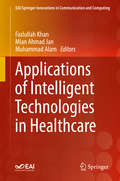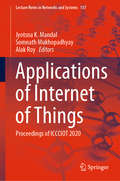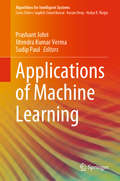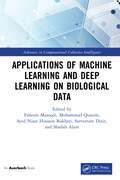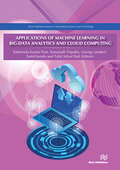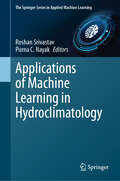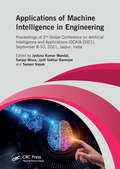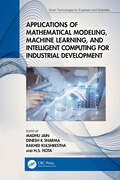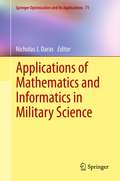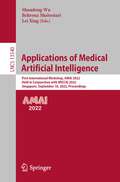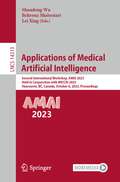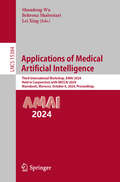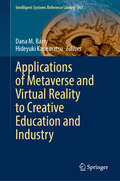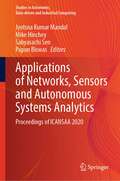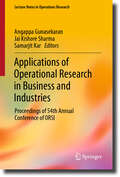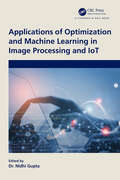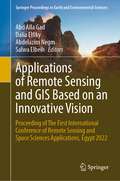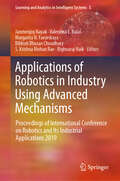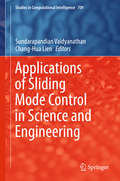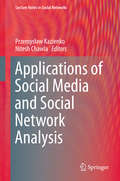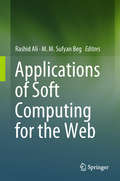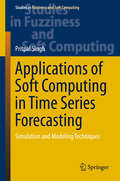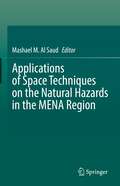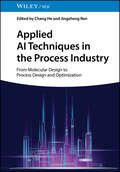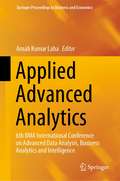- Table View
- List View
Applications of Intelligent Technologies in Healthcare (EAI/Springer Innovations in Communication and Computing)
by Muhammad Alam Fazlullah Khan Mian Ahmad JanThis book covers topics related to medical practices from communications technology point of view. The book provides detailed inside information about the use of health informatics and emerging technologies for the well-being of patients. Each chapter in this book focuses on a specific development in the use of informatics in healthcare. In general, each chapter uses various emerging technologies such as Internet of Things (IoT), Big Data, Cloud computing, Wireless Body Area Networks (WBAN), for various health-related illness, such as tuberculosis, heart diseases, asthma and various epidemic outbreaks. The book is intended both for communications engineers with a healthcare focus and medical researchers.
Applications of Internet of Things: Proceedings of ICCCIOT 2020 (Lecture Notes in Networks and Systems #137)
by Somnath Mukhopadhyay Jyotsna K. Mandal Alak RoyThis book features extended versions of selected papers from the International Conference on Computer Communication and Internet of Things (ICCCIoT 2020). Presenting recent research addressing new trends and challenges, and promising technologies and developments, it covers various topics related to IoT (Internet of Things) and communications, and machine learning for applications such as energy management systems, smart asthma alerts, smart irrigation systems, cloud healthcare systems, preventing side channel attacks, and cooperative spectrum sensing in cognitive radio networks.
Applications of Machine Learning (Algorithms for Intelligent Systems)
by Prashant Johri Sudip Paul Jitendra Kumar VermaThis book covers applications of machine learning in artificial intelligence. The specific topics covered include human language, heterogeneous and streaming data, unmanned systems, neural information processing, marketing and the social sciences, bioinformatics and robotics, etc. It also provides a broad range of techniques that can be successfully applied and adopted in different areas. Accordingly, the book offers an interesting and insightful read for scholars in the areas of computer vision, speech recognition, healthcare, business, marketing, and bioinformatics.
Applications of Machine Learning and Deep Learning on Biological Data (Advances in Computational Collective Intelligence)
by Faheem Masoodi Mohammad Quasim Sarvottam Dixit Shadab Alam Bukhari, Syed Nisar HussainThe automated learning of machines characterizes machine learning (ML). It focuses on making data-driven predictions using programmed algorithms. ML has several applications, including bioinformatics, which is a discipline of study and practice that deals with applying computational derivations to obtain biological data. It involves the collection, retrieval, storage, manipulation, and modeling of data for analysis or prediction made using customized software. Previously, comprehensive programming of bioinformatical algorithms was an extremely laborious task for such applications as predicting protein structures. Now, algorithms using ML and deep learning (DL) have increased the speed and efficacy of programming such algorithms. Applications of Machine Learning and Deep Learning on Biological Data is an examination of applying ML and DL to such areas as proteomics, genomics, microarrays, text mining, and systems biology. The key objective is to cover ML applications to biological science problems, focusing on problems related to bioinformatics. The book looks at cutting-edge research topics and methodologies in ML applied to the rapidly advancing discipline of bioinformatics. ML and DL applied to biological and neuroimaging data can open new frontiers for biomedical engineering, such as refining the understanding of complex diseases, including cancer and neurodegenerative and psychiatric disorders. Advances in this field could eventually lead to the development of precision medicine and automated diagnostic tools capable of tailoring medical treatments to individual lifestyles, variability, and the environment. Highlights include: Artificial Intelligence in treating and diagnosing schizophrenia An analysis of ML’s and DL’s financial effect on healthcare An XGBoost-based classification method for breast cancer classification Using ML to predict squamous diseases ML and DL applications in genomics and proteomics Applying ML and DL to biological data
Applications of Machine Learning in Big-Data Analytics and Cloud Computing
by Sumit Kundu Subhendu Kumar Pani Somanath Tripathy George Jandieri Talal Ashraf ButtCloud Computing and Big Data technologies have become the new descriptors of the digital age. The global amount of digital data has increased more than nine times in volume in just five years and by 2030 its volume may reach a staggering 65 trillion gigabytes. This explosion of data has led to opportunities and transformation in various areas such as healthcare, enterprises, industrial manufacturing and transportation. New Cloud Computing and Big Data tools endow researchers and analysts with novel techniques and opportunities to collect, manage and analyze the vast quantities of data. In Cloud and Big Data Analytics, the two areas of Swarm Intelligence and Deep Learning are a developing type of Machine Learning techniques that show enormous potential for solving complex business problems. Deep Learning enables computers to analyze large quantities of unstructured and binary data and to deduce relationships without requiring specific models or programming instructions.This book introduces the state-of-the-art trends and advances in the use of Machine Learning in Cloud and Big Data Analytics. The book will serve as a reference for Data Scientists, systems architects, developers, new researchers and graduate level students in Computer and Data science. The book will describe the concepts necessary to understand current Machine Learning issues, challenges and possible solutions as well as upcoming trends in Big Data Analytics.
Applications of Machine Learning in Hydroclimatology (The Springer Series in Applied Machine Learning)
by Roshan Srivastav Purna C. NayakApplications of Machine Learning in Hydroclimatology is a comprehensive exploration of the transformative potential of machine learning for addressing critical challenges in water resources management. The book explores how artificial intelligence can unravel the complexities of hydrological systems, providing researchers and practitioners with cutting-edge tools to model, predict, and manage these systems with greater precision and effectiveness. It thoroughly examines the modeling of hydrometeorological extremes, such as floods and droughts, which are becoming increasingly difficult to predict due to climate change. By leveraging AI-driven methods to forecast these extremes, the book offers innovative approaches that enhance predictive accuracy. It emphasizes the importance of analyzing non-stationarity and uncertainty in a rapidly evolving climate landscape, illustrating how statistical and frequency analyses can improve hydrological forecasts. Moreover, the book explores the impact of climate change on flood risks, drought occurrences, and reservoir operations, providing insights into how these phenomena affect water resource management. To provide practical solutions, the book includes case studies that showcase effective mitigation measures for water-related challenges. These examples highlight the use of machine learning techniques such as deep learning, reinforcement learning, and statistical downscaling in real-world scenarios. They demonstrate how artificial intelligence can optimize decision-making and resource management while improving our understanding of complex hydrological phenomena. By utilizing machine learning architectures tailored to hydrology, the book presents physics-guided models, data-driven techniques, and hybrid approaches that can be used to address water management issues. Ultimately, Applications of Machine Learning in Hydroclimatology empowers researchers, practitioners, and policymakers to harness machine learning for sustainable water management. It bridges the gap between advanced AI technologies and hydrological science, offering innovative solutions to tackle today's most pressing challenges in water resources.
Applications of Machine intelligence in Engineering: Proceedings of 2nd Global Conference on Artificial Intelligence and Applications (GCAIA, 2021), September 8-10, 2021, Jaipur, India
by Jyotsna Kumar MandalThe Global Conference on Artificial Intelligence and Applications (GCAIA 2021) provides a prominent venue for researchers, engineers, entrepreneurs, and scholar students to share their research ideas in the area of AI. Academic researchers would reveal the results and conclusions of laboratory based investigations via the GCAIA 21 platform, which bridges the gap between academia, industry, and government ethics. The GCAIA 21 platform will also bring together regional and worldwide issues to explore current advancements in contemporary Computation Intelligence. This Conference Proceedings volume contains the written versions of most of the contributions presented during the conference of GCAIA 2021. The conference has provided an excellent chance for researchers from diverse locations to present and debate their work in the field of artificial intelligence and its applications. It includes a selection of 62 papers. All accepted papers were subjected to strict peer-review by 2–4 expert referees. The papers have been selected for this volume because of their quality and their relevance to the theme of the conference.
Applications of Mathematical Modeling, Machine Learning, and Intelligent Computing for Industrial Development (Smart Technologies for Engineers and Scientists)
by Madhu Jain Rakhee Kulshrestha Dinesh K. Sharma H. S. HotaThe text focuses on mathematical modeling and applications of advanced techniques of machine learning, and artificial intelligence, including artificial neural networks, evolutionary computing, data mining, and fuzzy systems to solve performance and design issues more precisely. Intelligent computing encompasses technologies, algorithms, and models in providing effective and efficient solutions to a wide range of problems, including the airport’s intelligent safety system. It will serve as an ideal reference text for senior undergraduate, graduate students, and academic researchers in fields that include industrial engineering, manufacturing engineering, computer engineering, and mathematics. The book- Discusses mathematical modeling for traffic, sustainable supply chain, vehicular Ad-Hoc networks, and internet of things networks with intelligent gateways. Covers advanced machine learning, artificial intelligence, fuzzy sys- tems, evolutionary computing, and data mining techniques for real- world problems. Presents applications of mathematical models in chronic diseases such as kidney and coronary artery diseases. Highlights advances in mathematical modeling, strength, and benefits of machine learning and artificial intelligence, including driving goals, applicability, algorithms, and processes involved. Showcases emerging real-life topics on mathematical models, machine learning, and intelligent computing using an interdisciplinary approach. The text presents emerging real-life topics on mathematical models, machine learning, and intelligent computing in a single volume. It will serve as an ideal text for senior undergraduate students, graduate students, and researchers in diverse fields, including industrial and manufacturing engineering, computer engineering, and mathematics.
Applications of Mathematics and Informatics in Military Science (Springer Optimization and Its Applications #71)
by Nicholas DarasAnalysis, assessment, and data management are core tools required for operation research analysts. The April 2011 conference held at the Helenic Military Academy addressed these issues with efforts to collect valuable recommendations for improving analysts' capabilities to assess and communicate the necessary qualitative data to military leaders. This unique volume is an outgrowth of the April conference and comprises of contributions from the fields of science, mathematics, and the military, bringing Greek research findings to the world. Topics cover a wide variety of mathematical methods used with application to defense and security. Each contribution considers directions and pursuits of scientists that pertain to the military as well as the theoretical background required for methods, algorithms, and techniques used in military applications. The direction of theoretical results in these applications is conveyed and open problems and future areas of focus are highlighted. A foreword will be composed by a member of N.A.T.O. or a ranking member of the armed forces. Topics covered include: applied OR and military applications, signal processing, scattering, scientific computing and applications, combat simulation and statistical modeling, satellite remote sensing, and applied informatics - cryptography and coding. The contents of this volume will be of interest to a diverse audience including military operations research analysts, the military community at large, and practitioners working with mathematical methods and applications to informatics and military science.
Applications of Medical Artificial Intelligence: First International Workshop, AMAI 2022, Held in Conjunction with MICCAI 2022, Singapore, September 18, 2022, Proceedings (Lecture Notes in Computer Science #13540)
by Lei Xing Shandong Wu Behrouz ShabestariThis book constitutes the refereed proceedings of the first International Workshop on Applications of Medical Artificial Intelligence, AMAI 2022, held in conjunction with MICCAI 2022, in Singapore, in September 2022. The book includes 17 papers which were carefully reviewed and selected from 26 full-length submissions.Practical applications of medical AI bring in new challenges and opportunities. The AMAI workshop aims to engage medical AI practitioners and bring more application flavor in clinical, evaluation, human-AI collaboration, new technical strategy, trustfulness, etc., to augment the research and development on the application aspects of medical AI, on top of pure technical research.
Applications of Medical Artificial Intelligence: Second International Workshop, AMAI 2023, Held in Conjunction with MICCAI 2023, Vancouver, BC, Canada, October 8, 2023, Proceedings (Lecture Notes in Computer Science #14313)
by Lei Xing Shandong Wu Behrouz ShabestariThis book constitutes the refereed proceedings of the first International Workshop on Applications of Medical Artificial Intelligence, AMAI 2023, held in conjunction with MICCAI 2023, in Vancouver, Canada in October 2023. The book includes 17 papers which were carefully reviewed and selected from 26 full-length submissions.The AMAI 2023 workshop created a forum to bring together researchers, clinicians, domain experts, AI practitioners, industry representatives, and students to investigate and discuss various challenges and opportunities related to applications of medical AI.
Applications of Medical Artificial Intelligence: Third International Workshop, AMAI 2024, Held in Conjunction with MICCAI 2024, Marrakesh, Morocco, October 6, 2024, Proceedings (Lecture Notes in Computer Science #15384)
by Lei Xing Shandong Wu Behrouz ShabestariThis book constitutes the refereed proceedings of the Third International Workshop on Applications of Medical Artificial Intelligence, AMAI 2024, held in conjunction with MICCAI 2024, in Marrakesh, Morocco on October 6th, 2024. The volume includes 24 papers which were carefully reviewed and selected from 59 submissions. The AMAI 2024 workshop created a forum to bring together researchers, clinicians, domain experts, AI practitioners, industry representatives, and students to investigate and discuss various challenges and opportunities related to applications of medical AI.
Applications of Metaverse and Virtual Reality to Creative Education and Industry (Intelligent Systems Reference Library #267)
by Hideyuki Kanematsu Dana M. BarryThis book provides excellent examples of metaverse and virtual reality and their unlimited possibilities for education and industry. By examining innovative educational activities in both real and virtual worlds, such as Second Life, SL (a three-dimensional world where avatars perform specific tasks on behalf of us), we get a unique perspective on how these technologies can revolutionize learning and professional practices. Metaverse offers a fully immersive and interconnected virtual environment, enabling individuals to engage in digital experiences that closely resemble real-world interactions, thereby providing limitless possibilities for education and industry. In addition, the chapters cover various key topics, including the integration of virtual reality in creative game design, the use of VR (virtual reality) headsets with sensor glasses for physiological data collection, and the application of VR in fields like architecture and medical education. Artificial Intelligence, Robotics, and Machine Learning (along with other related fields) are also mentioned. In addition, readers will encounter discussions about the future fusion of real and virtual worlds, highlighting the role of Digital Twin Technology and Augmented Reality. The book invites readers to consider critical questions about the implications of these technologies for society and industry. This book is a must-read for students, educators, engineers, and researchers interested in the cutting-edge applications of virtual reality and the metaverse. It serves as a textbook, reference, and practical guide, making it invaluable for academic audiences and professionals seeking to harness the power of these technologies for innovative solutions. Whether you are a professor, scientist, or engineer, or simply curious about the metaverse, avatars, and virtual reality, this book promises to be a rewarding journey into the limitless potential of these technologies for creative education and industry.
Applications of Networks, Sensors and Autonomous Systems Analytics: Proceedings of ICANSAA 2020 (Studies in Autonomic, Data-driven and Industrial Computing)
by Mike Hinchey Papun Biswas Jyotsna Kumar Mandal Sabyasachi SenThis book presents high-quality research papers presented at International Conference on Applications of Networks, Sensors and Autonomous Systems Analytics (ICANSAA 2020), held during December, 11 – 12, 2020, at JIS College of Engineering, Kalyani, West Bengal, India. The major topics covered are cyber-physical systems and sensor networks, data analytics and autonomous systems and MEMS and NEMS with applications in biomedical devices. It includes novel and innovative work from experts, practitioners, scientists, and decision-makers from academia and industry.
Applications of Operational Research in Business and Industries: Proceedings of 54th Annual Conference of ORSI (Lecture Notes in Operations Research)
by Samarjit Kar Angappa Gunasekaran Jai Kishore SharmaEffective decision-making while trading off the constraints and conflicting multiple objectives under rapid technological developments, massive generation of data, and extreme volatility is of paramount importance to organizations to win over the time-based competition today. While agility is a crucial issue, the firms have been increasingly relying on evidence-based decision-making through intelligent decision support systems driven by computational intelligence and automation to achieve a competitive advantage. The decisions are no longer confined to a specific functional area. Instead, business organizations today find actionable insight for formulating future courses of action by integrating multiple objectives and perspectives. Therefore, multi-objective decision-making plays a critical role in businesses and industries. In this regard, the importance of Operations Research (OR) models and their applications enables the firms to derive optimum solutions subject to various constraints and/or objectives while considering multiple functional areas of the organizations together. Hence, researchers and practitioners have extensively applied OR models to solve various organizational issues related to manufacturing, service, supply chain and logistics management, human resource management, finance, and market analysis, among others. Further, OR models driven by AI have been enabled to provide intelligent decision-support frameworks for achieving sustainable development goals.The present issue provides a unique platform to showcase the contributions of the leading international experts on production systems and business from academia, industry, and government to discuss the issues in intelligent manufacturing, operations management, financial management, supply chain management, and Industry 4.0 in the Artificial Intelligence era. Some of the general (but not specific) scopes of this proceeding entail OR models such as Optimization and Control, Combinatorial Optimization, Queuing Theory, Resource Allocation Models, Linear and Nonlinear Programming Models, Multi-objective and multi-attribute Decision Models, Statistical Quality Control along with AI, Bayesian Data Analysis, Machine Learning and Econometrics and their applications vis-à-vis AI & Data-driven Production Management, Marketing and Retail Management, Financial Management, Human Resource Management, Operations Management, Smart Manufacturing & Industry 4.0, Supply Chain and Logistics Management, Digital Supply Network, Healthcare Administration, Inventory Management, consumer behavior, security analysis, and portfolio management and sustainability. The present issue shall be of interest to the faculty members, students, and scholars of various engineering and social science institutions and universities, along with the practitioners and policymakers of different industries and organizations.
Applications of Optimization and Machine Learning in Image Processing and IoT
by Dr Nidhi GuptaThis book presents state-of-the-art optimization algorithms followed by Internet of Things (IoT) fundamentals. The applications of machine learning and IoT are explored, with topics including optimization, algorithms and machine learning in image processing and IoT. Applications of Optimization and Machine Learning in Image Processing and IoT is a complete reference source, providing the latest research findings and solutions for optimization and machine learning algorithms. The chapters examine and discuss the fields of machine learning, IoT and image processing. KEY FEATURES: • Includes fundamental concepts towards advanced applications in machine learning and IoT. • Discusses potential and challenges of machine learning for IoT and optimization • Reviews recent advancements in diverse researches on computer vision, networking and optimization field. • Presents latest technologies such as machine learning in image processing and IoT This book has been written for readers in academia, engineering, IT specialists, researchers, industrial professionals and students, and is a great reference for those just starting out in the field as well as those at an advanced level.
Applications of Remote Sensing and GIS Based on an Innovative Vision: Proceeding of The First International Conference of Remote Sensing and Space Sciences Applications, Egypt 2022 (Springer Proceedings in Earth and Environmental Sciences)
by Abdelazim Negm Abd Alla Gad Dalia Elfiky Salwa ElbeihThis book covers various aspects of remote sensing and geographic information systems, from the perspective of earth and environmental sciences. The theme of applications of remote sensing and geographic information systems for the purposes of sustainable development highlights the innovative usage of space imaged spectral data in soil characterization. This book merges the selected contributions to the First International Conference of Remote Sensing and Space Sciences Applications (Egypt 2022) aiming to promote the latest findings on the development of Space Technologies and Applications.
Applications of Robotics in Industry Using Advanced Mechanisms: Proceedings of International Conference on Robotics and Its Industrial Applications 2019 (Learning and Analytics in Intelligent Systems #5)
by Margarita N. Favorskaya Janmenjoy Nayak Bighnaraj Naik Valentina E. Balas Bibhuti Bhusan Choudhury S. Krishna Mohan RaoThis book shares important findings on the application of robotics in industry using advanced mechanisms, including software and hardware. It presents a collection of recent trends and research on various advanced computing paradigms such as soft computing, robotics, smart automation, power control, and uncertainty analysis. The book constitutes the proceedings of the 1st International Conference on Application of Robotics in Industry using Advanced Mechanisms (ARIAM2019), which offered a platform for sharing original research findings, presenting innovative ideas and applications, and comparing notes on various aspects of robotics. The contributions highlight the latest research and industrial applications of robotics, and discuss approaches to improving the smooth functioning of industries. Moreover, they focus on designing solutions for complex engineering problems and designing system components or processes to meet specific needs, with due considerations for public health and safety, including cultural, societal, and environmental considerations. Taken together, they offer a valuable resource for researchers, scientists, engineers, professionals and students alike.
Applications of Sliding Mode Control in Science and Engineering (Studies in Computational Intelligence #709)
by Sundarapandian Vaidyanathan Chang-Hua LienGathering 20 chapters contributed by respected experts, this book reports on the latest advances in and applications of sliding mode control in science and engineering. The respective chapters address applications of sliding mode control in the broad areas of chaos theory, robotics, electrical engineering, physics, chemical engineering, memristors, mechanical engineering, environmental engineering, finance, and biology. Special emphasis has been given to papers that offer practical solutions, and which examine design and modeling involving new types of sliding mode control such as higher order sliding mode control, terminal sliding mode control, super-twisting sliding mode control, and integral sliding mode control. This book serves as a unique reference guide to sliding mode control and its recent applications for graduate students and researchers with a basic knowledge of electrical and control systems engineering.
Applications of Social Media and Social Network Analysis (Lecture Notes in Social Networks)
by Przemysław Kazienko Nitesh ChawlaThis collection of contributed chapters demonstrates a wide range of applications within two overlapping research domains: social media analysis and social network analysis. Various methodologies were utilized in the twelve individual chapters including static, dynamic and real-time approaches to graph, textual and multimedia data analysis. The topics apply to reputation computation, emotion detection, topic evolution, rumor propagation, evaluation of textual opinions, friend ranking, analysis of public transportation networks, diffusion in dynamic networks, analysis of contributors to communities of open source software developers, biometric template generation as well as analysis of user behavior within heterogeneous environments of cultural educational centers. Addressing these challenging applications is what makes this edited volume of interest to researchers and students focused on social media and social network analysis.
Applications of Soft Computing for the Web
by Rashid Ali Mm Sufyan BegThis book discusses the applications of different soft computing techniques for the web-based systems and services. The respective chapters highlight recent developments in the field of soft computing applications, from web-based information retrieval to online marketing and online healthcare. In each chapter author endeavor to explain the basic ideas behind the proposed applications in an accessible format for readers who may not possess a background in these fields. This carefully edited book covers a wide range of new applications of soft computing techniques in Web recommender systems, Online documents classification, Online documents summarization, Online document clustering, Online market intelligence, Web usage profiling, Web data extraction, Social network extraction, Question answering systems, Online health care, Web knowledge management, Multimedia information retrieval, Navigation guides, User profiles extraction, Web-based distributed information systems, Web security applications, Internet of Things Applications and so on. The book is aimed for researchers and practitioner who are engaged in developing and applying intelligent systems principles for solving real-life problems. Further, it has been structured so that each chapter can be read independently of the others.
Applications of Soft Computing in Time Series Forecasting: Simulation and Modeling Techniques (Studies in Fuzziness and Soft Computing #330)
by Pritpal SinghThis book reports on an in-depth study of fuzzy time series (FTS) modeling. It reviews and summarizes previous research work in FTS modeling and also provides a brief introduction to other soft-computing techniques, such as artificial neural networks (ANNs), rough sets (RS) and evolutionary computing (EC), focusing on how these techniques can be integrated into different phases of the FTS modeling approach. In particular, the book describes novel methods resulting from the hybridization of FTS modeling approaches with neural networks and particle swarm optimization. It also demonstrates how a new ANN-based model can be successfully applied in the context of predicting Indian summer monsoon rainfall. Thanks to its easy-to-read style and the clear explanations of the models, the book can be used as a concise yet comprehensive reference guide to fuzzy time series modeling, and will be valuable not only for graduate students, but also for researchers and professionals working for academic, business and government organizations.
Applications of Space Techniques on the Natural Hazards in the MENA Region
by Mashael M. Al SaudThis book introduces a comprehensive understanding in the use of space techniques in natural hazards and risk management in the MENA Region. The book is based on different case-studies from 25 MENA countries, and will be useful in highlighting the issues from all aspects. In recent years the number of natural hazard events has increased in the MENA Region. This is exacerbated by the changing climate and extreme climate events, as well as a large increase in the population in this area. Disastrous events occur on a yearly basis characterized by a vulnerability of physical processes. Floods, earthquakes, and mass movement result in severe damage to property and livelihoods, and have devastating effects upon the environment. These events cause severe financial losses, which on an annual basis, can exceed millions of dollars. The predication, assessment and monitoring approaches remain inadequate in managing these hazards and in mitigating their impacts, but with the development of space techniques and geo-information systems, these situations can now be better managed. The miscellany of satellite images, with different spatial and temporal resolutions, enable the detection of terrain features and provide indications of potential natural risks. This book will of interest to stakeholders, including field experts, academics, researchers and decision makers.
Applied AI Techniques in the Process Industry: From Molecular Design to Process Design and Optimization
by Jingzheng Ren Chang HeThorough discussion of data-driven and first principles models for energy-relevant systems and processes, approached through various in-depth case studies Applied AI Techniques in the Process Industry identifies and categorizes the various hybrid models available that integrate data-driven models for energy-relevant systems and processes with different forms of process knowledge and domain expertise. State-of-the-art techniques such as reduced-order modeling, sparse identification, and physics-informed neural networks are comprehensively summarized, along with their benefits, such as improved interpretability and predictive power. Numerous in-depth case studies regarding the covered models and methods for data-driven modeling, process optimization, and machine learning are presented, from screening high-performance ionic liquids and AI-assisted drug design to designing heat exchangers with physics-informed deep learning. Edited by two highly qualified academics and contributed to by a number of leading experts in the field, Applied AI Techniques in the Process Industry includes information on: Integration of observed data and reaction mechanisms in deep learning for designing sustainable glycolic acidMachine learning-aided rational screening of task-specific ionic liquids and AI for property modeling and solvent tailoringIntegration of incomplete prior knowledge into data-driven inferential sensor models under the variational Bayesian frameworkAI-aided high-throughput screening, optimistic design of MOF materials for adsorptive gas separation, and reduced-order modeling and optimization of cooling tower systemsSurrogate modeling for accelerating optimization of complex systems in chemical engineering Applied AI Techniques in the Process Industry is an essential reference on the subject for process, chemical, and pharmaceutical engineers seeking to improve physical interpretability in data-driven models to enable usage that scales with a system and reduce inaccuracies and mismatch issues.
Applied Advanced Analytics: 6th IIMA International Conference on Advanced Data Analysis, Business Analytics and Intelligence (Springer Proceedings in Business and Economics)
by Arnab Kumar LahaThis book covers several new areas in the growing field of analytics with some innovative applications in different business contexts, and consists of selected presentations at the 6th IIMA International Conference on Advanced Data Analysis, Business Analytics and Intelligence. The book is conceptually divided in seven parts. The first part gives expository briefs on some topics of current academic and practitioner interests, such as data streams, binary prediction and reliability shock models. In the second part, the contributions look at artificial intelligence applications with chapters related to explainable AI, personalized search and recommendation, and customer retention management. The third part deals with credit risk analytics, with chapters on optimization of credit limits and mitigation of agricultural lending risks. In its fourth part, the book explores analytics and data mining in the retail context. In the fifth part, the book presents some applications of analytics to operations management. This part has chapters related to improvement of furnace operations, forecasting food indices and analytics for improving student learning outcomes. The sixth part has contributions related to adaptive designs in clinical trials, stochastic comparisons of systems with heterogeneous components and stacking of models. The seventh and final part contains chapters related to finance and economics topics, such as role of infrastructure and taxation on economic growth of countries and connectedness of markets with heterogenous agents, The different themes ensure that the book would be of great value to practitioners, post-graduate students, research scholars and faculty teaching advanced business analytics courses.
